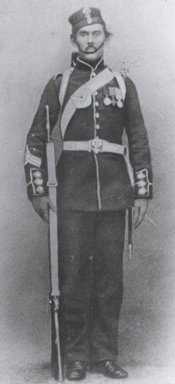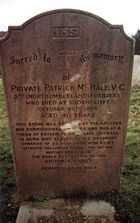Patrick McHale
| Patrick McHale | |
|---|---|
 | |
| Born |
1826 Killala, County Mayo |
| Died |
26 October 1866 (aged 39-40) Shorncliffe, Kent |
| Buried at | Shorncliffe Military Cemetery, Kent |
| Allegiance |
|
| Service/branch |
|
| Rank | Private |
| Unit | 5th Regiment of Foot |
| Battles/wars | Indian Mutiny |
| Awards | Victoria Cross |
Patrick McHale VC (1826 – 26 October 1866) was born in Killala, County Mayo and was an Irish recipient of the Victoria Cross, the highest and most prestigious award for gallantry in the face of the enemy that can be awarded to British and Commonwealth forces.
Details
He was approximately 31 years old, and a private in the 1st Battalion, 5th Regiment of Foot (later The Northumberland Fusiliers) British Army during the Indian Mutiny when the following deeds took place for which he was awarded the VC:
1st Battalion, 5th Regiment Private Patrick M'HaleDate of Acts of Bravery, 2nd October and 22nd December, 1857.
For conspicuous bravery at Lucknow on the 2nd October, 1857, when he was the first man at the capture of one of the guns at the Cawnpore Battery,—and again, on the 22 December 1857, when, by a bold rush, he was the first to take possession of one of the enemy's guns, which had sent several rounds of grape through his company, which was skirmishing up to it. On every occasion of attack, Private M'Hale has been the first to meet the foe, amongst whom he caused such consternation by the boldness of his rush, as to leave little work for those who followed to his support. By his habitual coolness and daring, and sustained bravery in action, his name has become a household word for gallantry among his comrades.
This was a reprisal for the rebellion of Cawnpore in India's First war of Independence 1857 Research by a noted Indian historian Amaresh Misra suggests that more than 7000 locals were executed in the immediate violence of this event by British soldiers.[1] and that up to 10 million Indians were killed during the mutiny of 1857 and 10 years that followed in an attempt from British soldiers to crush the mutiny.
Further information
He died at Shorncliff, Kent on 26 October 1866 and was buried at Shorncliffe Military Cemetery, near Folkestone, Kent, England. Section I - Upper Right. Headstone.
The medal

His Victoria Cross is displayed in the Northumberland Fusiliers Museum at Alnwick Castle, Northumberland, England.
References
- ↑ The London Gazette: no. 22396. p. 2316. 19 June 1860. Retrieved 17 September 2009.
Listed in order of publication year
- The Register of the Victoria Cross (1981, 1988 and 1997)
- Clarke, Brian D. H. (1986). "A register of awards to Irish-born officers and men". The Irish Sword XVI (64): 185–287.
- Irelands VCs ISBN 1-899243-00-3 (Dept of Economic Development 1995)
- Monuments to Courage (David Harvey, 1999)
- Irish Winners of the Victoria Cross (Richard Doherty & David Truesdale, 2000)